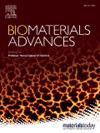用于生物打印和制造肺模型的脱细胞肺ecm生物连接的开发和表征
IF 6
2区 医学
Q2 MATERIALS SCIENCE, BIOMATERIALS
Materials Science & Engineering C-Materials for Biological Applications
Pub Date : 2025-07-22
DOI:10.1016/j.bioadv.2025.214428
引用次数: 0
摘要
构建模拟天然肺生理结构的体外三维肺组织模型是组织工程领域的一个巨大挑战。虽然生物打印技术的进步使3D肺模型的制造成为可能,但生物墨水和打印结构往往无法实现所需的机械和生物特性。为此,我们的目标是开发一种新的生物墨水,并用它来打印和表征体外三维肺模型。我们制备了猪肺细胞外基质(LdECM),然后将其与其他水凝胶-海藻酸盐,羧甲基纤维素(CMC)和胶原蛋白结合,合成新的生物墨水。对合成的生物油墨的印刷性能、力学性能和生物学性能进行了表征。我们还对生物墨水的流变性能进行了表征,确定了3% w/v海藻酸盐、0.5% w/v CMC、0.5 mg/mL 1型胶原和1% v/v猪LdECM的生物墨水组成适合生物打印。为了制作三维肺模型,我们策略性地设计和打印了MRC-5人肺成纤维细胞和A549-ACE2人肺上皮细胞的空间组织模式,并采用杯状结构限制上皮细胞。我们的研究结果表明,黏度在60 ~ 90pa之间的生物墨水。S是合适的,这导致高打印分辨率的细胞负载构建和良好的细胞活力。生物打印肺结构也显示出与天然肺组织刚度相当的弹性模量为2-4 kPa。我们的研究结果为开发肺特异性3D生物打印模型奠定了基础,以解决全球呼吸系统疾病日益流行的问题,并推进临床前治疗测试。本文章由计算机程序翻译,如有差异,请以英文原文为准。
Development and characterization of a decellularized lung ECM-based bioink for bioprinting and fabricating a lung model
The construction of three-dimensional (3D) in vitro lung tissue models mimicking the physiological structure of the native lung poses a huge challenge in tissue engineering. While advances in bioprinting technology has made fabrication of 3D lung models feasible, the bioinks and printed constructs often fall short in achieving desired mechanical and biological properties. Toward this, we aimed to develop a novel bioink and use it to print and characterize in vitro 3D lung models with living cells. We generated porcine lung extracellular matrix (LdECM) which was then strategically combined with other hydrogels – alginate, carboxymethylcellulose (CMC), and collagen, to synthesize novel bioinks. The printability, mechanical and biological properties of the synthesized bioinks was characterized. We also characterized the rheological properties and identified the bioink composition – 3 % w/v alginate, 0.5 % w/v CMC, 0.5 mg/mL collagen Type 1 and 1 % v/v porcine LdECM was appropriate for bioprinting. To fabricate 3D lung models, we strategically designed and printed constructs featuring spatially organized patterns of MRC-5 human lung fibroblasts and A549-ACE2 human lung epithelial cells along with a cup-shaped structure to confine epithelial cells. Our results demonstrated that the bioinks with viscosities between 60 and 90 Pa.s were appropriate, which resulted in high printing resolution of cell-laden constructs and excellent cell viability. The bioprinted lung constructs also exhibited an elastic modulus of 2–4 kPa comparable to the stiffness of native lung tissues. Our findings establish a foundation for developing lung-specific 3D bioprinted models to address the growing global prevalence of respiratory diseases and for advancing preclinical therapeutic testing.
求助全文
通过发布文献求助,成功后即可免费获取论文全文。
去求助
来源期刊
CiteScore
17.80
自引率
0.00%
发文量
501
审稿时长
27 days
期刊介绍:
Biomaterials Advances, previously known as Materials Science and Engineering: C-Materials for Biological Applications (P-ISSN: 0928-4931, E-ISSN: 1873-0191). Includes topics at the interface of the biomedical sciences and materials engineering. These topics include:
• Bioinspired and biomimetic materials for medical applications
• Materials of biological origin for medical applications
• Materials for "active" medical applications
• Self-assembling and self-healing materials for medical applications
• "Smart" (i.e., stimulus-response) materials for medical applications
• Ceramic, metallic, polymeric, and composite materials for medical applications
• Materials for in vivo sensing
• Materials for in vivo imaging
• Materials for delivery of pharmacologic agents and vaccines
• Novel approaches for characterizing and modeling materials for medical applications
Manuscripts on biological topics without a materials science component, or manuscripts on materials science without biological applications, will not be considered for publication in Materials Science and Engineering C. New submissions are first assessed for language, scope and originality (plagiarism check) and can be desk rejected before review if they need English language improvements, are out of scope or present excessive duplication with published sources.
Biomaterials Advances sits within Elsevier''s biomaterials science portfolio alongside Biomaterials, Materials Today Bio and Biomaterials and Biosystems. As part of the broader Materials Today family, Biomaterials Advances offers authors rigorous peer review, rapid decisions, and high visibility. We look forward to receiving your submissions!

 求助内容:
求助内容: 应助结果提醒方式:
应助结果提醒方式:


